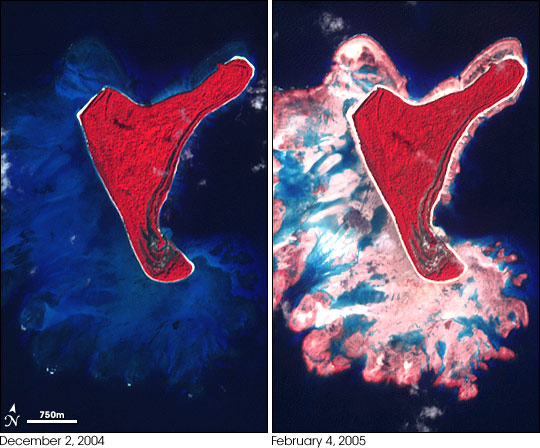


On December 26, 2004, one of the largest earthquakes in recorded history struck offshore of the island of Sumatra, Indonesia. The ocean floor heaved in some places and sank in others, creating catastrophic tsunamis that raced across the Indian Ocean. Hundreds of thousands of people died as the waves struck coastlines from Thailand to Sri Lanka to Somalia. In addition to tsunami damage, satellite images of reefs, islands, and coastlines identified signs of permanent elevation change—sinking or uplift—along the fault between the Indo-Australia and Burma plates.
In places such as North Reef Island, shown in this pair of images from the Advanced Spaceborne Thermal Emission and Reflection Radiometer (ASTER) on NASA’s Terra satellite, the quake lifted the reefs permanently out of the water. The images use visible and infrared light detected by ASTER to make different land surfaces stand out clearly from one another: water is blue, vegetation is red, coral or bare sand appears white. In the “before” image, from December 2, 2004, the submerged reef creates a bright blue glow around the island. In the “after” image, from February 4, 2005, the white coral stands completely up out of the water. It is even tinged with red, which suggests the exposed coral had died, and algae had colonized it.
In the weeks and months after the earthquake, satellite images provided broad coverage of an area where ground-based observations were initially very limited. A team of scientists led by Caltech Ph.D. geology student Aron Meltzner discovered changes in elevation along nearly 1,600 kilometers (994 miles) of the tectonic plate boundary. The images revealed that the earthquake rupture extended 100 kilometers (62 miles) farther north than estimates based on seismic and Global Positioning System (GPS) data suggested.
The feature article Rise and Fall: Satellites Reveal Full Length of Tsunami-Generating Earthquake describes how scientists used satellite images to map the length of the earthquake rupture zone. The article includes additional satellite and ground-based images of elevation changes resulting from the 2004 Aceh-Andaman earthquake.
On December 26, 2004, one of the largest earthquakes in recorded history struck offshore of the island of Sumatra, Indonesia. The ocean floor heaved in some places and sank in others, creating catastrophic tsunamis that raced across the Indian Ocean. Hundreds of thousands of people died as the waves struck coastlines from Thailand to Sri Lanka to Somalia. In addition to tsunami damage, satellite images of reefs, islands, and coastlines identified signs of permanent elevation change—sinking or uplift—along the fault between the Indo-Australia and Burma plates.
In places such as North Reef Island, shown in this pair of images from the Advanced Spaceborne Thermal Emission and Reflection Radiometer (ASTER) on NASA’s Terra satellite, the quake lifted the reefs permanently out of the water. The images use visible and infrared light detected by ASTER to make different land surfaces stand out clearly from one another: water is blue, vegetation is red, coral or bare sand appears white. In the “before” image, from December 2, 2004, the submerged reef creates a bright blue glow around the island. In the “after” image, from February 4, 2005, the white coral stands completely up out of the water. It is even tinged with red, which suggests the exposed coral had died, and algae had colonized it.
In the weeks and months after the earthquake, satellite images provided broad coverage of an area where ground-based observations were initially very limited. A team of scientists led by Caltech Ph.D. geology student Aron Meltzner discovered changes in elevation along nearly 1,600 kilometers (994 miles) of the tectonic plate boundary. The images revealed that the earthquake rupture extended 100 kilometers (62 miles) farther north than estimates based on seismic and Global Positioning System (GPS) data suggested.
The feature article Rise and Fall: Satellites Reveal Full Length of Tsunami-Generating Earthquake describes how scientists used satellite images to map the length of the earthquake rupture zone. The article includes additional satellite and ground-based images of elevation changes resulting from the 2004 Aceh-Andaman earthquake.
NASA images created by Jesse Allen, Earth Observatory, using data provided courtesy of the NASA/GSFC/MITI/ERSDAC/JAROS, and U.S./Japan ASTER Science Team.